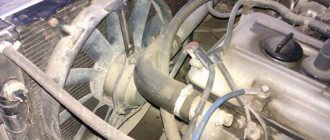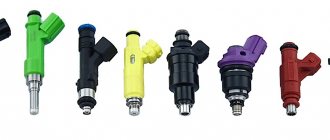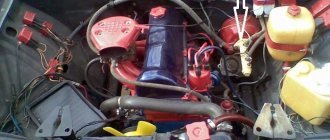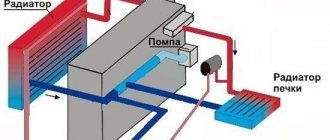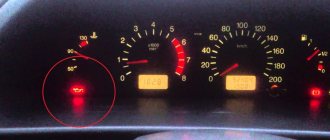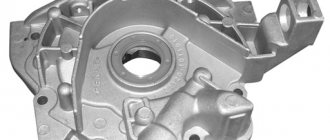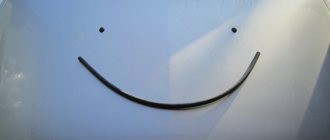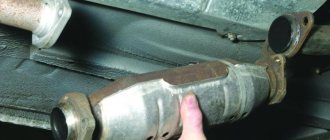Failures of a diesel engine turbine, despite the 10-year service life declared by the manufacturers, are quite common. At the same time, the performance of the motor depends on the functioning of this structural element. From this we can draw the following conclusion:
- The turbine requires regular maintenance.
- Turbine design
The turbine housing installed together with the diesel engine is made of cast iron. During active use of the vehicle, the beds located under the bearings, as well as the sealing ring sockets, often fail.
The turbine itself looks like a snail shell. The compressor moves through a shaft on which the impeller is mounted. The first is made of an aluminum alloy, characterized by increased resistance to heat, and the second is made of medium-alloy steel. Due to the design features of both elements, in case of breakdown they are replaced with new ones.
The turbine has a rather complex shape. Exhaust gases are supplied through its internal part, pumped by a compressor, due to which the initial engine power is increased.
Signs of trouble
Manufacturing a turbine is a rather labor-intensive process, despite the apparent simplicity of its design. Manufacturers of the unit have to measure its dimensions to fractions of a millimeter.
Before repairing diesel engine turbines, it is necessary to carry out preliminary diagnostics.
Any errors during the restoration of the TCR lead to a sharp increase in the cost of work due to the high cost of the unit. To identify faults and eliminate them, you will need the help of an experienced specialist. However, you can diagnose the motor yourself. The following signs of turbine malfunction may indicate problems with the engine:
- Exhaust gases have acquired a black, bluish or bluish tint.
- The motor began to make a lot of noise in different operating modes.
- The engine temperature regularly reaches high levels (overheating is observed).
- The power plant began to consume noticeably more fuel and oil.
- The appearance of clear pops while the engine is running, a whistle or a dull hum.
- Reduced vehicle dynamics due to decreased traction levels. At low speeds the power unit is unstable.
- Oil smell appears.
Balancing equipment
The turbine repair ends with its testing on a test bench to simulate operation on vehicles. Technical parameters are checked in all modes: idle, medium and high.
Using computer stands, the operation of a turbine on your car is simulated. Moreover, the turbine is checked in all engine operating modes: idle, medium and high.
Causes of breakdowns
Turbocharger malfunctions occur for a number of reasons.
Most often, diesel engine and turbine breakdowns occur due to untimely oil changes.
Long-term use of old lubricant or the ingress of water or fuel into it leads to rapid wear of the bearings, blockage of the oil channels or damage to the axle. The faulty element must be replaced. It cannot be repaired. The described consequences result from using too thick oil.
The second most “popular” cause of problems with a turbocharger is a decrease in pressure in the oil hoses caused by improper installation of these elements or the turbine itself. This problem can lead to rapid wear of the rings, shaft journal, and bearings.
It is important to note: running a diesel engine for 5 minutes without oil causes serious and irreparable damage to the power unit.
We should also not forget that foreign objects can get into the turbocharger. Their appearance in an operating turbine leads to breakdowns of the wheel and rotor blades, which reduces the level of pressure generated.
Typical errors
Before you repair a modern diesel turbine with your own hands, you need to remember a common mistake made by beginners. There are gaps between the body, bushing and shaft of the cartridge that are filled with oil during operation. They allow you to compensate for the damper effect.
Inexperienced mechanics regard this as excessive play and install bushings of non-standard sizes, which are mounted “in tension”. As a result, the rotation of the rotor becomes difficult, and the bushing wears out intensively due to the damping effect and lack of lubrication. This often causes shaft deformation.
Also, we must not forget about balancing, which is performed on a special stand. It is possible to balance a part yourself, but it requires skill and attention. Repair and assembly errors lead to irreversible damage to an expensive unit. Therefore, in case of any difficulty, it is better to contact specialists.
Turbine repair
It is recommended to have your engine repaired at a specialized station. However, you can troubleshoot some problems yourself.
First, you need to visually inspect the turbine and evaluate its operation. Do-it-yourself turbine repair begins with checking the oil level and its quality. In addition, the likelihood of foreign objects entering the structure should be assessed.
If these reasons have been excluded, then you can begin to analyze the color of the exhaust. A change in color, as well as a decrease in thrust, often indicate problems with the intake or exhaust. In the first case, we are talking about a decrease in the volume of supplied air, in the second – about the presence of leaks.
To check the operation of the turbine, you need to start the engine. The power unit should not make any extraneous sounds such as creaking or whistling. In a working engine with a turbine, air does not escape from the connections. Next you need to check the condition of the air filter.
Basically, problems with the functioning of the intake and exhaust arise precisely with this element. If the filter looks normal, then next you need to check the oil drain line. It often develops kinks, damage or plugs.
Next comes the turn of the rotor. It needs to be rotated several times around its axis.
If the rotor clings to the turbine housing, it must be repaired.
When the engine makes a lot of noise during operation, you should check:
- All pipelines to identify their wear.
- Turbine axis.
- Rotor.
If there are problems with any of the described structural elements, qualified repairs of the engine and turbine will be required.
The presence of malfunctions may be indicated by incorrect operation of the supercharging system. To check the latter, you will need outside help. First of all, you should find the pipe that connects the turbine and the intake manifold. Then you need to start the engine and clamp the specified pipe by hand.
At the same moment, the second person should press the gas pedal and hold it for 3 to 5 minutes. A working pipe responds to such driver actions by inflating under pressure. The described experiment must be repeated 3-4 times. If in none of the cases does the pipe inflate, then the turbine is faulty.
Regardless of what “symptoms” appear that indicate problems with the supercharging system, it is recommended to carefully inspect the pipes, flanges, manifolds and other engine elements for cracks.
What is a turbine cartridge?
Essentially, the cartridge is a turbocharger, except for 3 parts, such as:
- turbine housing (hot snail);
- compressor (cold snail);
- adjustment valve.
The turbine cartridge itself consists of a bearing housing, which houses a shaft with turbine and compressor wheels mounted on it. This mechanism creates the basis of a balanced, rotating functional apparatus, in which, for its operation, it is only necessary to limit the movement of exhaust and atmospheric gases. Actually, this is what a hot and cold snail is for.
Do-it-yourself cartridge repair or turbo service specialists
Such a difficult task should be entrusted to a certified specialist who uses original spare parts
and works on European equipment.
Anyone who has ever had to undergo even a partial repair of a turbine
.
The price of a turbine cartridge is lower than that of a turbocharger. Although, as a result of replacing only the cartridge, you get an almost new turbocharger, with completely preserved technical characteristics. Most people prefer to buy a turbine cartridge and replace it themselves. This process will not cause any difficulties for the car enthusiast. There is no need to balance the turbine cartridge - the cartridge was already balanced when assembled at the factory.
How to replace a turbine cartridge yourself
Quite often, a turbocharger refuses to work due to unpleasant mistakes made during its installation. Therefore, it is important to adhere to precision, cleanliness and neatness while working with it.
Step-by-step instructions for replacing the turbine cartridge
- First you need to remove the part from the engine - this is where any repair of a turbocharger begins. Disconnect the oil drain and oil lines, as well as the water cooling, but keep the gasket intact unless it requires replacement.
- Be sure to remember the location of all the pipes, use your phone to take a couple of pictures, or sketch them on paper. This will help you avoid mistakes when installing the compressor in its place.
- Disconnect the suction and injection connections of the compressor.
- When dismantling the compressor housing, remember its location relative to the turbine housing; this important detail will be needed during subsequent assembly. With extreme caution, you must first remove the compressor housing, and then the turbines. Spring claws and a piece of fabric to protect the surface are best suited for this job.
- Using a spring vice, remove the retaining ring. It often becomes covered with rust, so removing it often takes a lot of effort and time. To do this, you can use tapping with a mallet or rubberized hammer. This dynamic load will help remove it.
- Carefully inspect the entire internal surface of the cases. If damage is detected (a trace of an impact, a scratch, a piece of metal), there is no point in changing the turbine cartridge, since the diameter of the housings is damaged.
- Before final assembly, the turbine should be cleaned of excess old oil and carbon deposits - this will extend the life of the compressor.
- The time has come to assemble the turbine, and the sketches and photos made earlier will help you with this. It is necessary to restore the original position of the blocks and tubes with utmost precision. It's better to do it in reverse. Do not forget to check the presence of oil in the oil pipes before connecting them.
- Manually perform a couple of revolutions of the compressor wheel to confirm that nothing is preventing the shaft with wheels from rotating. The turbine should be re-disassembled if any noise or friction is heard.
- To normalize the pressure and prevent a “dry start”, you need to turn off the ignition and make a few revolutions.
- Run the engine at idle speed for 5 minutes and then check for oil leaks. The absence of leakage indicates that the middle housing is installed correctly and is ready for use. And if there is one, then it is necessary to check all connections, tubes (for the presence of clamps and kinks) and the condition of the gaskets (one of them could have moved or been installed incorrectly).
Preventing turbine malfunctions
To increase the life of the turbine, you need to follow a few simple rules:
- Use only high-quality oil and fuel.
- Avoid quick turbine flushes. This procedure can completely disable the unit at once.
- Change air filters promptly.
- The oil must be changed after every 7 thousand kilometers.
- Be sure to warm up a car with a turbocharged diesel engine.
- At the end of a long trip, the car should idle for three minutes. This will prevent the appearance of carbon deposits.
- Regular diagnostics of the power plant.
Why change the cartridge?
Firstly, is it worth paying a decent amount for the entire part if you can save money by replacing only one unit? There is a certain cohort of motorists who believe that there is no need to go to a car repair shop for this problem, but that they can carry out the replacement in their own garage and also save on work. But here it is necessary to warn that you can disassemble the cartridge without difficulty, but assembling it yourself without special equipment is very problematic. Secondly, cartridge replacement is sometimes required due to operational features, at the end of its service life, or in order to extend the service life of the entire unit. The third reason for replacing the cartridge is to prevent turbine malfunctions. To do this, it is necessary to carry out regular engine diagnostics, use only high-quality oil and monitor its level.
What are the advantages of replacing the cartridge?
There are several reasons that make replacing a cartridge a truly effective and profitable operation:
- low cost of the unit compared to the cost of the entire unit;
- speed of manipulation;
- an effective way to give new life to the unit;
- With a new cartridge, the unit works no less efficiently than a new turbine.
Experts note that correct replacement of the cartridge by professionals allows you to give the turbocharger a new life: not only does the service life of the entire unit increase, but also its performance characteristics.
Disadvantages of cartridge replacement
Car enthusiasts should know that while the cartridge replacement procedure is effective, it also has a number of disadvantages:
- in some cases, simply replacing the cartridge is not enough; individual elements need to be modified or replaced,
- Cartridge replacement should only be performed by service technicians,
- Cartridges for certain models are not always available,
- If the internal combustion engine is used incorrectly, the effectiveness of the manipulations is reduced to nothing.
In conclusion
Experts recommend not to strive to replace the turbocharger with a new one. It is possible that it is enough to replace only the cartridge, and this will allow you to use the capabilities of a turbocharged car to the fullest.
Do-it-yourself repair of diesel engine turbines
Author:
Maxim Markov
The effectiveness of a turbocharger when installed on an engine is beyond doubt. The power and torque of the motor increases significantly. Long-term operation and untimely maintenance eventually lead to the need to repair diesel engine turbines. But before carrying out such maintenance, you should remember the structure of this unit and correctly diagnose a violation of normal operation.
We work throughout the Russian Federation
We suggest sending the faulty device by carrier, by regular bus, by train or by any other means. Our technicians will conduct a visual and instrumental inspection of the system on the day of your call. If a unit requires surgical intervention, our service worker will send a photo report and a defective statement, and will also discuss all the nuances with the client. Functional equipment is sent back in the agreed manner.
You can clarify all questions regarding the delivery of turbines to us by calling the manager by phone:
8 (495) 648-69-27
Turbine purpose and resource
The operation of a turbocharger is aimed at increasing the flow of supplied air into the combustion chamber.
This leads to more complete and rapid combustion of fuel, resulting in greater efficiency from the engine at the required operating conditions. Designers do not have to increase the engine displacement and carry out complex technical upgrades. Turbocharging is used both on diesel engines and gasoline units. In this case, diesel engines demonstrate greater efficiency. This is due to the high compression ratio of the diesel fuel unit and the lower number of revolutions during operation. Recently, a gas turbine engine, which has already been developed for tractors and trucks, has been called promising.
Given the high repair costs, owners strive to keep the turbocharger operational for as long as possible. Increasing the service life is directly related to understanding the operating features of the turbine supercharger. The impeller starts working from the first seconds of starting the engine, and stops a few seconds after the crankshaft stops. At low engine speeds, the exhaust gas pressure does not allow the turbine to spin. Switching on occurs with increasing speed, and the engine seems to get a second wind.
Initially, the service life of the supercharger is not inferior to that of the engine itself. Premature turbine failure is associated with high temperature loads and high rotation speeds.
Description of the turbocharger design - nuances
One of the common mistakes regularly made by those who decide to independently repair a turbocharger is associated with a misunderstanding of the damping effect inherent in the design of the bearing unit of the unit. It is this question that requires some clarification, since misunderstanding can lead to dire consequences.
The need for damping is related to the operating characteristics of the engine. The exhaust gases enter the exhaust manifold and then onto the turbine impeller in portions in accordance with how the engine exhaust valves open. Thus, the flow is not uniform - its effect on the turbine rotor is of a pulsed nature. To compensate for the impact, it would be necessary to give the rotor much greater rigidity, which would lead to an increase in the size and weight of the entire unit. A solution was found in the form of using floating bushings in sliding bearings, which perform a damping function on the housing side.
There is a certain gap between the floating bushing and the housing, in which an oil film is formed, almost identical to that formed between the rotor and the bushing. The bushing rotates at a frequency approximately half the rotor speed, and two oil films successfully compensate for the pulsed effect of exhaust gases on the turbine rotor, performing shock-absorbing functions.
When independently repairing a turbine, an allegedly increased play between the bushing and the housing can be diagnosed; this is taken as a defect, after which bushings are machined from the appropriate material (usually bronze), which are pressed into the housing with some interference. The analogy is obvious - these bushings resemble the bushings in the connecting rod head or in the starter, but this error leads to dire consequences. The turbine operates at extreme conditions, and the absence of one oil film leads to a decrease in the damping effect, which causes the wear of the plain bearings to increase many times over. In extreme cases, the rotor shaft may even break.
Design features
To understand possible failures, one should also recall the design of the turbine used with diesel engines. The turbocharging system includes:
- Compressor impeller.
- Supercharger impeller.
- Support shaft.
- Bearing assembly.
- Lubrication fitting.
- Boost pressure control regulator.
When the turbine operates, the air heats up, which leads to an increase in its density. Therefore, it is necessary to turn on the cooler (intercooler) to return the parameters to normal.
Sliding bearings receive the greatest impact in operation, taking into account the high rotation speed. Therefore, the importance of maintenance in terms of timely oil changes is very high. By the way, engine oil for a diesel engine with a turbine should be selected only taking into account the manufacturer’s recommendations.
Other reasons that disrupt the normal operation of the turbine include a sharp start on a cold engine, stopping the engine after an intense rhythm without waiting to idle.
What is needed to restore a turbocharger
If the car owner is confident in his capabilities, then the following devices will be useful for the turbocharger restoration procedure:
- Inserts of several sizes;
- Oil seals;
- Rings;
- Screws;
- Washers;
- Screws;
- Spare earbuds;
- Socket and open-end wrenches;
- Screwdrivers;
- Mallet;
- Puller;
- Figure swimsuit;
- Nippers with sliding jaws.
It is easier to disassemble iron than to assemble it. It is advisable to designate all the fastening points of the turbine elements and their location relative to each other.
To understand possible failures of the mechanism, you should first study the design of the diesel engine turbine. The turbocharging system includes:
- Compressor impeller;
- Supercharger impeller;
- Support shaft;
- Bearing assembly;
- Lubrication fitting;
- Boost pressure control regulator.
Possible malfunctions and their diagnosis
- Engine oil leaks and gets into the air entering the cylinders.
- Air leaking through the pipe seals, loss of power.
- Clogged supply and discharge oil channels.
- The appearance of cracks or deformations of the turbine housing or parts.
- Insufficient air flow through the air filter.
It is easier to detect malfunctions of a diesel engine turbine at the initial stage by analyzing the exhaust gases. Their color allows you to preliminarily determine a possible deviation:
- a blue tint indicates oil droplets entering the air;
- White smoke will indicate that the oil discharge channel is clogged;
- black smoke indicates a lack of air in the cylinders, i.e. about the leak.
Additional signs of turbine malfunction are expressed in the loss of dynamic characteristics of the machine. An imminent breakdown also means the appearance of extraneous noise in the operation of the turbine. This may be due to wear of bearings, deformation of the housing and moving parts.
When the first signs appear, do not immediately rush to paid diagnostics. It is not difficult to check the operation of a diesel engine turbine with your own hands. First of all, taking into account the symptoms, we check the engine oil level. If the level decrease is more than 1 liter per thousand km, then we analyze the color of the exhaust.
When white and bluish smoke is detected, the question of how to check a turbine on a diesel engine is solved using the following algorithm:
- Recall when the air filter was last replaced. If air flow is poor, a pressure difference occurs between the bearing block and the housing. Oil begins to penetrate into the turbocharger housing. This is the cause of the blue smoke. If the filter is clean, move on to the second stage.
- Checking the oil outlet channel. The presence of bends, cracks or a regular plug makes the oil removal circuit from the turbine faulty. In some cases, it is enough to clean the channels, and their normal condition will lead to the restoration of all indicators. Another reason for this behavior of the turbine is a violation of normal ventilation of crankcase gases. You can't do this without the help of a mechanic.
- At the next stage, the condition of the mechanical parts of the turbine is checked. The axial play is checked, which contributes to the possible contact of the impeller with the turbine walls. Any nicks or abrasions require immediate removal. Here, the question of how to check a diesel engine turbine will only be answered by a specialized service center.
When eliminating play, fine adjustment is required. For example, the axial displacement of the shaft should not exceed 0.05 mm, and the radial play is allowed at a maximum value of 1 mm. Agree that adjustment is possible only after replacing worn parts using special instruments.
Timely detection of abnormalities in operation will help to avoid costly repairs. It is likely that with early diagnosis of faults, their elimination will be achievable by flushing and replacing consumables.
Repair work
After successful dismantling of this mechanism, we proceed to a thorough inspection of each of its component parts. It doesn’t matter at all whether repairing a diesel turbine with your own hands concerns a regular model of the device or a biturbo, the sequence will not change. If there are no obvious mechanical damages on the impellers of the turbine and compressor parts, as well as on the surface of the volutes, they must be thoroughly cleaned with fine sand. It also helps to use small glass beads when cleaning.
When analyzing other structural elements, you can encounter the following defects:
- Damage to one or more blades on the compressor wheel. It is not advisable to level or solder the blade yourself; it is better to simply purchase a new part. In addition, it is advisable to replace the air filter and check the intake manifold for integrity and leaks.
- A similar problem, only with the turbine wheel. It is also better to buy a new part, replace the old one, and evaluate the integrity of the intake tract.
- Defective condition of additional small elements, such as support bearing, rings, bushing, etc. To eliminate the malfunction, you need to purchase new parts, notice them, and install a new shaft.
You can and should repair a turbocharger yourself, but only when you fully understand its structure and operating principle. All nuances should be taken into account when assembling this mechanism, since the quality of operation of the entire power plant as a whole depends on this. If you still have some doubts, it is better not to skimp and entrust the repair of the turbine to the specialists of the service station.
Turbine repair from Rover:
Do-it-yourself repair of a turbine from a diesel engine:
Nissan Qashqai 2022 - Innovations in a new body
Ferrari F12 Berlinetta – Dream or reality
Lada 21099 turbo PROJECT ORIGIN › Logbook › DIY turbine (turbocharger) repair
Before repairing the turbine, it is necessary to carefully inspect it from the outside in order to identify the presence of all components, external defects and deformations.
Then both “snails” are removed from the turbine and the condition of both impellers is visually determined. Quite often, impellers have physical damage that is visible to the naked eye. Such damage immediately indicates that turbine repair is inevitable. If the turbine drives oil
Then, all components of the turbine are examined to determine the suitability of each part for restoration. Parts found to be unsuitable must be replaced with new ones.
Repair of turbines of diesel and gasoline engines is basically no different and occurs in several stages:
After this, the parts that have undergone shot blasting are washed again to wash off and completely remove any solid particles that may remain on the parts. Numerous damage to the compressor wheel blades.
In addition to visually visible damage to the impellers, the main damage is damage to the support bearings, retaining rings, bushings and the shaft itself. Typically, these damages occur from a lack of oil supply to the working surfaces during turbine operation or the use of non-recommended oils. Increased wear of the shaft journal.
Cause: The quantity or pressure of oil supplied to the TKR is less than required. During repairs, you may have to replace the shaft with a new one. In most cases, the shaft does not change. Significant uneven wear of the shaft journal.
Cause: Dirty oil. When repairing, it is necessary to replace the shaft with a new one. Significant uneven bearing wear.
Cause: Dirty oil. During repairs, all bearings are replaced with new ones. Burnt oil in the oil passages of the bearings.
Reason: Engine overheating or sudden engine shutdown, poor quality oil. During repairs, all bearings are replaced with new ones. Starting to repair the turbine yourself.
The turbine shaft is then measured for wear. If the wear of the turbine shaft is within normal limits, then it is sent to a special turning and grinding machine, where it is ground to repair size. The groove of the locking ring is straightened on a special machine. Then the balancing process occurs. It consists of two stages. First, the turbine shaft is balanced in two planes of the turbine wheel. After this, bushings and a compressor impeller are installed on the shaft and, in this form, it is again sent for balancing. Balancing the turbine on a stand.
There are separate specialized stands for balancing turbines for trucks and cars.
During balancing work, special balancing marks are applied along which the turbine “cartridge” is assembled. In principle, the result is an assembled turbine only without the “snails”.
The cartridge assembled in this way is sent for testing to a balancing stand, where compressed air is supplied to the “cold” impeller and the turbine is spun up to 5,000 rpm.
If all turbine parameters are normal, then “snails” are screwed to the cartridge.
Own warehouse of spare parts for turbines in Moscow
- Wide range of parts in stock. The constant availability of running parts allows us to repair units from any manufacturer.
- Replacement of worn components. Thanks to the use of new spare parts, the repaired product is no different from the one that just came off the production line.
We repair the turbine with our own hands
For many car enthusiasts who love power and speed, the issue of buying a car with a turbocharged engine is very important.
In turn, the task of a turbocharger is to supply a larger volume of air to the engine cylinders and, as a result, increase the engine’s power.
The only drawback of such a useful element is its frequent failure, so every car enthusiast should be able to make at least minimal repairs to the turbine.
Design features of the engine turbine
Structurally, a turbocharger is a very simple mechanism that consists of several basic elements:
- Common body of the assembly and cochlea;
- Sliding bearing;
- Thrust bearing;
- Spacer and thrust bushing.
The turbine housing is made of aluminum alloy, and the shaft is made of steel.
Therefore, if these elements fail, the only correct solution is replacement.
Most turbine damage can be easily diagnosed and repaired. In this case, the work can be entrusted to professionals in their field or you can do everything yourself.
In principle, there is nothing complicated about this (we will look at how to dismantle and repair a turbine in the article).
conclusions
In the absence of serious defects, repairing a turbine takes no more than a few hours. But with the help of available tools and material prepared in advance, you can make very high-quality and budget-friendly repairs.
Published by Author on March 20, 2019
It is not recommended to disassemble and repair the turbine yourself at home or in a garage. The main reason is the lack of special equipment for diagnosing and repairing the unit. The restoration of turbines in the workshop takes place under the most sterile conditions, since the smallest grain of sand that gets into a spare part can put it out of working order in a matter of minutes. Is it possible to repair the turbine yourself and how to do it, we will tell you in the following theses:
Main malfunctions and their causes
As operating practice shows, there are two main causes of breakdowns - poor quality or untimely maintenance.
If a technical inspection is carried out according to plan, the turbine will operate for a long time and without any special complaints from motorists.
So, today we can identify several main signs and reasons for turbine failure:
- 1. The appearance of blue smoke from the exhaust pipe when the speed increases and its absence when the norm is reached. The main reason for this malfunction is oil getting into the combustion chamber due to a leak in the turbine.
- 2. Black smoke from the exhaust pipe indicates combustion of the fuel mixture in the intercooler or injection line. The probable cause is damage or breakdown of the TKR (turbocharger) control system.
- 3. White smoke from the exhaust pipe indicates a clogged turbine oil drain line. In such a situation, only cleaning can save you.
- 4. Excessive oil consumption up to one liter per thousand kilometers. In this case, you need to pay attention to the turbine and the presence of leaks. In addition, it is advisable to inspect the joints of the pipes.
- 5. The dynamics of acceleration are “dulled”. This is a clear symptom of lack of air in the engine. The reason is a malfunction or breakdown of the TKR (turbocharger) control system.
- 6. A whistle appears when the engine is running. The probable cause is an air leak between the engine and the turbine.
- 7. A strange grinding noise during turbine operation often indicates the appearance of a crack or deformation in the unit housing. In most cases, with such symptoms, the TCR does not “live” for a long time and further repair of the turbine may be ineffective.
- 8. Increased noise during turbine operation can cause clogging of the oil line, changes in the rotor gaps and the latter touching the turbocharger housing.
- 9. An increase in exhaust toxicity or fuel consumption often indicates problems with the air supply to the TCR (turbocharger).
When should you contact us?
The following symptoms of malfunctions are grounds for contacting turbo service:
- Increased consumption of working fluid;
- Oil leakage from the turbocharger or connecting pipes;
- Increased fuel consumption;
- Loss of motor power;
- Deterioration in acceleration dynamics;
- Extraneous noise, grinding or whistling when the engine is running;
- Heavy exhaust smoke (black, white or blue smoke).
If you notice the first signs, contact a service center for engine diagnostics or maintenance. If the motor malfunction is related to the poor condition of the turbine, remove and bring the device to our base for a thorough inspection and subsequent repair. We will diagnose it through external inspection, using tools and on a stand using licensed computer programs.
Repairs and diagnostics of turbines are carried out by mechanics with at least 12 years of experience in this field.
Features of turbine dismantling
To repair the turbine yourself, it must be dismantled.
This is done in the following sequence:
- 1. Disconnect all pipelines that go to the turbine. In this case, you should be extremely careful not to damage the unit itself and the devices adjacent to it.
- 2. Remove the turbine and compressor volutes. The latter can be dismantled without problems, but the turbine scroll is often attached very tightly.
Here, dismantling can be done in two ways - using a mallet method or using the volute mounting bolts themselves (by gradually releasing them from all sides).
When performing work, you must be very careful not to damage the turbine wheel.
- 3. Once the work of dismantling the scrolls is completed, you can check for shaft play. If the latter is missing, then the problem is not in the shaft.
Again, a small lateral play is acceptable (but not more than one millimeter).
- 4. The next step is to remove the compressor wheels. To perform this job, pliers will be useful. When dismantling, keep in mind that the compressor shaft in most cases has a left-hand thread.
To remove the compressor wheel, a special puller is useful.
- 5. Next, the sealing liners are dismantled (they are located in the recesses of the rotor), as well as the thrust bearing (it is secured with three bolts, so there are no problems with removal).
- 6. Now you can remove the liners from the end part - they are secured using a retaining ring (sometimes you have to tinker during dismantling).
The plain bearings (compressor side) are secured with a retaining ring.
7. When performing dismantling work, it is necessary (regardless of the breakdown) to thoroughly rinse and clean the main elements - the cartridge, seals, rings and other components.
Disassembly
Further repair of the turbine with your own hands on a diesel engine continues by dismantling it. First, all the fixing bolts of the turbine and compressor housing parts are unscrewed. Often the first assembly is stuck tightly; to remove it, you can use a mallet, unscrewing the bolts evenly throughout the entire volute. Then it must be carefully moved away.
Care should be taken to ensure that the turbine wheel does not become deformed. Depending on the model of the unit, the compressor scroll can be secured with bolts or stoppers. After removing all the clamps, the cochlea itself is dismantled.
Then check for play in the cartridge. Transverse movement is allowed in small amounts, and there should be no longitudinal play. Otherwise, the element will need to be replaced. Using pliers with sliding jaws, remove the compressor retaining ring. The reverse side of the shaft is clamped using a figured straightener. When disassembling, remember that the part has a left-hand thread.
Repair features
Once dismantling is completed, repairs can be made. To do this, you should have a special repair kit on hand, which contains everything you need - liners, hardware, seals and rings.
Check the quality of fixation of the nominal liners. If they are loose, then they need to be sharpened and the shaft balanced.
In this case, it is advisable to clean the liners well and lubricate them with engine oil.
The retaining rings located inside the turbine must be installed in the cartridge. At the same time, make sure that they are in their place (in special grooves).
After this, you can mount the turbine liner, having previously lubricated it with engine oil. The liner is secured with a locking ring.
The next step is to install the compressor liner, after which the well-lubricated sleeve can be inserted.
Next, put the ring plate on it and tighten it thoroughly with the bolts (without fanaticism).
Install the skid plate (secured with a retaining ring) and oil scraper ring.
All that remains is to return the snails to their place. That's all.
This article indicates a general algorithm for disassembling and assembling a turbine. Of course, depending on the type of the latter, this algorithm will be partially changed, but the general progress of work will be identical.
Well, if a serious breakdown is detected, then it is better to immediately replace the old turbine with a new one.
Assembly
After the Volkswagen turbine has been repaired with its own hands, we begin to assemble the unit. Internal retaining rings are mounted into the cartridge. You need to make sure that they are tightly seated in their nests. Then the turbine liner is installed, lubricated with engine oil. After fixing the element with a stopper, insert the compressor liner. The bushing is lubricated, after which the oil scraper, plate and bolts are installed.
Tighten the fixing screws carefully with the required, but not excessive, force. Next, the dirt protection plate is attached using locking rings. Oil scraper rings are installed on the shaft. Here you will have to be patient, since the process is very difficult and monotonous. After lubricating the shaft, it is mounted and tightened using a nut with a force of about 4-5 Nm. The cleaned snails are put in place along with the valve (wastegate). The assembly bulkhead can be considered complete.
Do-it-yourself turbocharger repair - causes of malfunctions and instructions
Just ten years ago, a car turbocharger moved from the category of a special chic inherent only in selected cars to the category of a necessary part for every car. It serves to increase engine power and helps reduce fuel consumption. These parameters are becoming increasingly popular when choosing a car. Therefore, today every driver needs to know the structure of a turbocharger and be able to understand what its malfunctions are in order to navigate and diagnose the breakdown of his car in time. In addition to the design of the turbocharger, you should also know the features of your car model; for this you should read the repair and operating instructions for your car, for example, the repair instructions for GAZ 3110 and Chevrolet Lanos.
Turbocharger device.
- Turbine with impeller.
- Air centrifugal pump.
- Compressor.
- A rigid axis that connects them.
- Bearings, rings, valves, seals and other small parts.
These malfunctions do not always relate to problems with the turbocharger; sometimes it can be something else, for example, you need to repair the muffler yourself.
Exhaust gases escape from the engine and enter the turbine impeller. It converts their energy from kinetic to mechanical, and the pump through the air filter supplies fresh air to the compressor, which compresses it and sends it to the engine. This entire process helps increase engine power by 20-50%, increasing efficiency and fuel burning rate.
What are the types of turbocharger malfunctions and how to recognize them?
- Your engine suddenly seems to lose power.
- Black or dark blue smoke comes out of the exhaust pipe.
- Oil consumption has increased.
- The sound of the engine and turbocharger has changed.
All this indicates that it’s time to make sure you have a turbocharger repair kit and check the serviceability of not only the turbocharger, but also, first of all, the car’s engine and all its attachments. Do not neglect this advice, because a well-maintained and properly functioning engine ensures trouble-free operation of the turbocharger for many years.
Is it possible to repair a turbocharger with your own hands? What equipment and skills are needed for this?
Let us say right away that not a single specialist will advise you to disassemble and repair the turbocharger yourself. The reasons for this are compelling and it will suffice to name at least one of them. For example, the slightest grain of sand entering a unit can damage it. But there is another opinion - if someone does it, then I can do it too! If you decide to disassemble and repair the turbocharger yourself, prepare a minimum turbocharger repair kit: liners of several sizes, a full set of all kinds of seals, rings, washers, screws, screws and spare liners. Be extremely careful and remember that taking something apart is easier than putting it back together. If possible, mark all the fastening points of the parts and their position relative to each other.
So, we begin repairing turbochargers in our own workshop.
- We remove the turbine and free it from all screws. We also unscrew the screws securing the snails.
- We check both impellers: turbine and compressor. They cannot be repaired, but will have to be replaced in case of malfunction.
- You can try to grind the shaft on which the compressor and turbine are mounted. Then you will need to replace the bearings with others that fit in size.
- To remove the compressor wheel, you will need pliers with sliding lips. And you must take into account that the compressor shaft has a left-hand thread!
- It is very difficult to check whether the shaft play is acceptable in a regular workshop. But here we take a risk, hoping for luck and the opportunity to go to the workshop later.
- Using a universal puller, we try to remove the compressor wheel from the shaft.
- Shaft bushings are very often the cause of backlash.
- We clean and rinse all parts with special products. During assembly, some components and parts are forcibly lubricated with oil, which is used when operating the car. The list of such details varies in each specific case.
- Don't forget to congratulate yourself after you managed to assemble the turbocharger! And if he still works, it’s time for you to think about changing your profession. There is a good salary at the service station...
Before you decide to disassemble and reassemble a turbocharger in less than ideal conditions, without having experience in such work, carefully weigh the pros and cons again.
A professional workshop has the opportunity to diagnose all components and parts of any turbocharger at all stages of repair, including before and after disassembly and assembly. And conditions of cleanliness have been created there, which cannot be achieved in a home workshop even if one wants to. After all, you don’t have a special unit in your garage - a high-pressure washing machine, for example? What about the balancing stand? As you understand, we strongly do not recommend repairing the turbocharger yourself and insist on it!
We check both impellers: turbine and compressor. They cannot be repaired, but will have to be replaced in case of malfunction. We advise on
Why choose us?
- Save up to 70% on the cost of a new unit. The price for a major overhaul of turbines is several times less than the purchase of a new device. The cost is announced after a comprehensive diagnosis and does not change.
- 3-year, unlimited mileage warranty. Thanks to direct cooperation with official dealers of original spare parts, we are confident in the high quality of operations and the durability of the equipment.
- Repair time is 4 hours. You don't have to wait weeks for your device or spare parts to arrive from the factory. The work is carried out by a team of 6 people with different specializations.
- We repair only failed components. We carry out orders only in cases where the equipment can be restored and specialists are confident that the breakdown will be eliminated. The cost of our services is reasonable. Therefore, if the problem is in a pipe, gasket or other minor problem, we will be honest about it and will not insist on a major repair.
- Constant availability of spare parts. We always have spare parts for many car models in stock at our warehouse. Therefore, we will repair cargo turbines and units for cars and trucks without unplanned downtime.
- We invite you on a tour. The client wants to be sure of receiving quality service. We invite everyone to visit the workshop and see how the specialists work.
- Free consultation. The master will answer all questions about the operation of turbocharged engines and independent monitoring of technical condition in order to avoid subsequent failures.
- Extensive network of customers. The high quality of our services is confirmed by many years of cooperation with individuals, enterprises of various types and official dealer services.
Call us on:
8 (495) 648-69-27
and we will answer all your questions!
